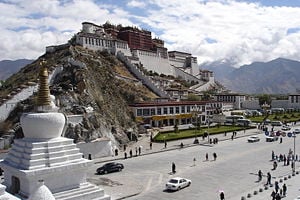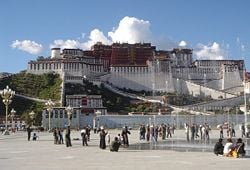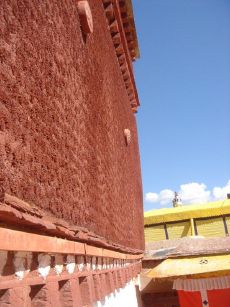| Historic Ensemble of the Potala Palace, Lhasa* | |
|---|---|
| UNESCO World Heritage Site | |

| |
| State Party | China |
| Type | Cultural |
| Criteria | i, iv, vi |
| Reference | 707 |
| Region** | Asia-Pacific |
| Inscription history | |
| Inscription | 1994 (18th Session) |
| Extensions | 2000; 2001 |
| * Name as inscribed on World Heritage List. ** Region as classified by UNESCO. | |
Potala Palace is the traditional residence of the Dalai Lama (the religious leader of the Gelug lineage of Tibetan Buddhism). The Potala Palace, located in the city of Lhasa, is named after Mount Potala, which is considered to be the sacred abode of the Buddhist deity, Avalokitesvara.[1]
Architecturally, the Palace building measures 400 metres east-west and 350 metres north-south, with sloping stone walls averaging three meters thick, and five meters (more than 16 ft) thick at the base, and with copper poured into the foundations to help proof it against earthquakes.[2] Thirteen stories of buildings—containing over 1,000 rooms, 10,000 shrines and about 200,000 statues—soar 117 metres (384 ft) on top of Marpo Ri, the "Red Hill," rising more than 300 m (about 1,000 ft) in total above the valley floor.[3] Tradition has it that the three main hills of Lhasa represent the "Three Protectors of Tibet." Chokpori, just to the south of the Potala, is the soul-mountain (bla-ri) of Vajrapani, Pongwari that of Manjushri, and Marpori, the hill on which the Potala stands, represents Chenresig or Avalokiteshvara.[4]
The palace functioned as the chief residence of the successive Dalai Lamas until 1959 when the current 14th Dalai Lama fled into exile to live in Dharmasala, India following the Chinese invasion of Tibet. Today, the Potala Palace has been converted into a museum by the Chinese. It is also a UNESCO World Heritage Site.
History
The site was used as a meditation retreat by King Songtsen Gampo, who in 637 C.E. built the first palace on the site in order to greet his bride Princess Wen Cheng of the Tang Dynasty of China.
Lozang Gyatso, the Great Fifth Dalai Lama, started the construction of the Potala Palace in 1645[5] after one of his spiritual advisers, Konchog Chophel (d. 1646), pointed out that the site was ideal as a seat of government, situated as it is between Drepung and Sera monasteries and the old city of Lhasa.[6] The Dalai Lama and his government moved into the Potrang Karpo ('White Palace') in 1649.[6] Construction lasted until 1694,[1] some twelve years after his death. The Potala was used as a winter palace by the Dalai Lama from that time onward. The Potrang Marpo ('Red Palace') was added between 1690 and 1694.[1]
- "The new palace got its name from a hill on Cape Comorin at the southern tip of India—a rocky point sacred to the God of Mercy, whom the Indians call Avalokitesvara and the Tibetans worship as Chenrezi. The Tibetans themselves rarely speak of the sacred place as the "Potala," but rather as "Peak Potala" (Tse Potala), or usually as "the Peak."[7]
The palace was slightly damaged during the Tibetan uprising against the Chinese in 1959, when Chinese shells were launched into the palace's windows. It also escaped damage during the Cultural Revolution in 1966 through the personal intervention of Zhou Enlai, who was then the Premier of the People's Republic of China but who personally opposed the revolution. Still, almost all of the over 100,000 volumes of scriptures, historical documents and other works of art were either removed, damaged or destroyed.[8]
The Potala Palace was inscribed to the UNESCO World Heritage List in 1994. In 2000 and 2001, Jokhang Temple and Norbulingka were added to the list as extensions to the sites. Rapid modernization has been a concern for UNESCO, which expressed worry over the building of modern structures immediately around the palace that threaten the palace's unique atmosphere.[9] The Chinese government responded by enacting a rule barring the building of any structure taller than 21 meters in the area. UNESCO was also concerned over the materials used during the restoration of the palace, which commenced in 2002 at a cost of RMB180 million (US$22.5 million), although the palace's director, Qiangba Gesang, has clarified that only traditional materials and craftsmanship were used. The palace has also received restoration works between 1989 to 1994, costing RMB55 million (US$6.875 million).
Daily visitorship to the palace was restricted to 1,600 a day, with opening hours reduced to six hours daily to avoid over-crowding from May 1, 2003. The palace was receiving an average of 1,500 a day prior to the introduction of the quota, sometimes peaking to over 5,000 in one day.[10] Visits to the structure's roof were banned after restoration works were completed in 2006 to avoid further structural damage.[11]
Architecture
Built at an altitude of 3,700 m (12,100 ft), on the side of Marpo Ri ('Red Mountain') in the center of Lhasa Valley,[12] the Potala Palace, with its vast inward-sloping walls broken only in the upper parts by straight rows of many windows, and its flat roofs at various levels, is not unlike a fortress in appearance. At the south base of the rock is a large space enclosed by walls and gates, with great porticos on the inner side. A series of staircases, broken by intervals of gentle ascent, lead to the summit.
The central part of this group of buildings rises in a vast quadrangular mass above its satellites to a great height, terminating in gilt canopies similar to those on the Jokhang. This central member of Potala is called the "red palace" from its crimson color, which distinguishes it from the rest. It contains the principal halls and chapels and shrines of past Dalai Lamas. There is in these much rich decorative painting, with jewelled work, carving and other ornamentation.
The Chinese Putuo Zongcheng Temple, built between 1767 and 1771, was modeled after the Potala Palace. It was named by the American television show Good Morning America and newspaper USA Today as one of the "New Seven Wonders".[13]
The Potrang Karpo or 'White Palace'
The White Palace is the part of the Potala Palace that makes up the living quarters of the Dalai Lamas. The first White Palace was built during the lifetime of the Fifth Dalai Lama and he and his government moved into it in 1649.[6] It then was extended to its size today by the thirteenth Dalai Lama in the early twentieth century. The White Palace was for secular uses and contained the living quarters, offices, the seminary and the printing house. A central, yellow-painted courtyard known as a Deyangshar separates the living quarters of the Lama and his monks from the Red Palace, the other side of the sacred Potala, which is completely devoted to religious study and prayer. It contains the sacred gold stupas—the tombs of eight Dalai Lamas—the monks' assembly hall, numerous chapels and shrines, and libraries for the important Buddhist scriptures, the Kangyur in 108 volumes and the Tengyur with 225. The yellow building at the side of the White Palace in the courtyard between the main palaces houses giant banners embroidered with holy symbols which hung across the south face of the Potala during New Year festivals.
The Potrang Marpo or 'Red Palace'
The Red Palace is part of the Potala palace that is completely devoted to religious study and Buddhist prayer. It consists of a complicated layout of many different halls, chapels and libraries on many different levels with a complex array of smaller galleries and winding passages:
The Great West Hall
The main central hall of the Red Palace is the Great West Hall which consists of four great chapels that proclaim the glory and power of the builder of the Potala, the Fifth Dalai Lama. The hall is noted for its fine murals reminiscent of Persian miniatures, depicting events in the fifth Dalai Lama's life. The famous scene of his visit to Emperor Shun Zhi in Beijing is located on the east wall outside the entrance. Special cloth from Bhutan wraps the Hall's numerous columns and pillars.
The Saint's Chapel
On the north side of this hall in the Red Palace is the holiest shrine of the Potala. A large blue and gold inscription over the door was written by the nineteenth-century Tongzhi Emperor of China proclaiming Buddhism a "Blessed Field of Wonderful Fruit." This chapel like the Dharma cave below it dates from the seventh century. It contains a small ancient jewel encrusted statue of Avalokitesvara and two of his attendants. On the floor below, a low, dark passage leads into the Dharma Cave where Songsten Gampo is believed to have studied Buddhism. In the holy cave are images of Songsten Gampo, his wives, his chief minister and Sambhota, the scholar who developed Tibetan writing in the company of his many divinities.
The North Chapel
The North Chapel centers on a crowned Sakyamuni Buddha on the left and the Fifth Dalai Lama on the right seated on magnificent gold thrones. Their equal height and shared aura implies equal status. On the far left of the chapel is the gold stupa tomb of the Eleventh Dalai Lama who died as a child, with rows of benign Medicine Buddhas who were the heavenly healers. On the right of the chapel are Avalokiteshvara and his historical incarnations including Songsten Gampo and the first four Dalai Lamas. Scriptures covered in silk between wooden covers form a specialized library in a room branching off it.
The South Chapel
The South Chapel centers on Padmasambhava, the eighth-century Indian magician and saint. His consort Yeshe Tsogyal, a gift from the King is by his left knee and his other wife from his native land of Swat is by his right. On his left, eight of his holy manifestations meditate with an inturned gaze. On his right, eight wrathful manifestations wield instruments of magic powers to subdue the demons of the Bön faith.
The East Chapel
The East chapel is dedicated to Tsong Khapa, founder of the Gelug tradition. His central figure is surrounded by lamas from Sakya Monastery who had briefly ruled Tibet and formed their own tradition until converted by Tsong Khapa. Other statues are displayed made of various different materials and display noble expressions.
The West Chapel
This is the chapel that contains the five golden stupas. The enormous central stupa, 14.85 metres (49 ft) high, contains the mummified body of the Fifth Dalai Lama. This stupa is built of sandalwood and is remarkably coated in 3,727 kg (8,200 lb) of solid gold and studded with 18,680 pearls and semi-precious jewels.[14] On the left is the funeral stupa for the Twelfth Dalai Lama and on the right that of the Tenth Dalai Lama. The nearby stupa for the 13th Dalai Lama is 22 meters (72 ft) high. The stupas on both ends contain important scriptures.[15]
The First Gallery
The first gallery is on the floor above the West chapel and has a number of large windows that give light and ventilation to the Great West Hall and its chapels below. Between the windows, superb murals show the Potala's construction in fine detail.
The Second Gallery
The Second Gallery gives access to the central pavilion that is used for visitors to the palace for refreshments and to buy souvenirs.
The Third Gallery
The Third Gallery, besides fine murals, has a number of dark rooms branching off it containing enormous collections of bronze statues and miniature figures made of copper and gold. The chanting hall of the Seventh Dalai Lama is on the south side and on the east is an entrance that connects the section to the Saints chapel and the Deyangshar between the two palaces.
The Tomb of the Thirteenth Dalai Lama
The tomb of the 13th Dalai Lama is located west of the Great West Hall and it can only be reached from an upper floor and with the company of a monk or a guide of the Potala. Built in 1933, the giant stupa contains priceless jewels and one ton of solid gold. It is 14 meters (46 feet) high. Devotional offerings include elephant tusks from India, porcelain lions and vases and a pagoda made from over 200,000 pearls. Elaborate murals in traditional Tibetan styles depict many events of the life of the Thirteenth Dalai Lama during the early twentieth century.
Notes
- ↑ 1.0 1.1 1.2 R.A. Stein, Tibetan Civilization (1962). Translated into English with minor revisions by the author, 1st English edition (London: Faber & Faber, 1972; Reprint: Stanford University Press, 1972), 84.
- ↑ Elisabeth B. Booz, Tibet (Hong Kong: Passport Books, 1986), 62-63.
- ↑ Michael Buckley and Robert Strausss, Tibet: a travel survival kit (South Yarra, Vic., Australia: Lonely Planet, ISBN 0-908086-88-1).
- ↑ Stein, p. 228.
- ↑ Thomas Laird, The Story of Tibet: Conversations with the Dalai Lama (New York: Grove Press, ISBN 978-0-8021-1827-1), 175.
- ↑ 6.0 6.1 6.2 Samten C. Karmay, 2005, "The Great Fifth," p. 1. Downloaded as a pdf file on 16th December, 2007 from: [1]
- ↑ Thomas Jr. Lowell, (1951) Out of this World: Across the Himalayas to Tibet, Reprint: 1952 (London: Macdonald & Co.), 181.
- ↑ Decline of Potala par Oser. Retrieved June 9, 2008.
- ↑ B.B.C. News: "Development 'not ruining' Potala" Retrieved June 9, 2008.
- ↑ Tourist entry restriction protects Potala Palace Retrieved June 9, 2008.
- ↑ Potala Palace bans roof tour Retrieved June 9, 2008.
- ↑ Stein, p. 206.
- ↑ ABC Good Morning America "7 New Wonders" Page Retrieved June 9, 2007.
- ↑ Chorten of the fifth Dalai Lama in the Potala Palace in Lhasa of Tibet Autonomous Region Retrieved June 9, 2008.
- ↑ Buckley and Strausss, p. 131.
ReferencesISBN links support NWE through referral fees
- Huber, Toni. 1999. "Reading the Potala." In Sacred Spaces and Powerful Places In Tibetan Culture: A Collection of Essays. The Library of Tibetan Works and Archives. ISBN 81-86470-22-0
- Laird, Thomas. 2006. The Story of Tibet: Conversations with the Dalai Lama. New York: Grove Press. ISBN 978-0-8021-1827-1
- Namgyal, Phuntsok. 2002. Splendor of Tibet: The Potala Palace, Jewel of the Himalayas. Homa & Sekey Books. ISBN 978-1931907026
- Stein, R.A. 1972. Tibetan Civilization. Translated by J. E. Stapleton Driver. Stanford: California: Stanford University Press. ISBN 0-8047-0806-1 (cloth); ISBN 0-8047-0901-7 (paper).
- Thomas, Lowell Jr. 1951. Out of this World: Across the Himalayas to Tibet. Reprint: 1952. London: Macdonald & Co.
- Wang, Tianxing. 1995. Potala Palace of Lhasa. China Esperanto Press. ISBN 978-7505202436
External links
All links retrieved November 30, 2022.
- Potala Palace (UNESCO)
Credits
New World Encyclopedia writers and editors rewrote and completed the Wikipedia article in accordance with New World Encyclopedia standards. This article abides by terms of the Creative Commons CC-by-sa 3.0 License (CC-by-sa), which may be used and disseminated with proper attribution. Credit is due under the terms of this license that can reference both the New World Encyclopedia contributors and the selfless volunteer contributors of the Wikimedia Foundation. To cite this article click here for a list of acceptable citing formats.The history of earlier contributions by wikipedians is accessible to researchers here:
The history of this article since it was imported to New World Encyclopedia:
Note: Some restrictions may apply to use of individual images which are separately licensed.








